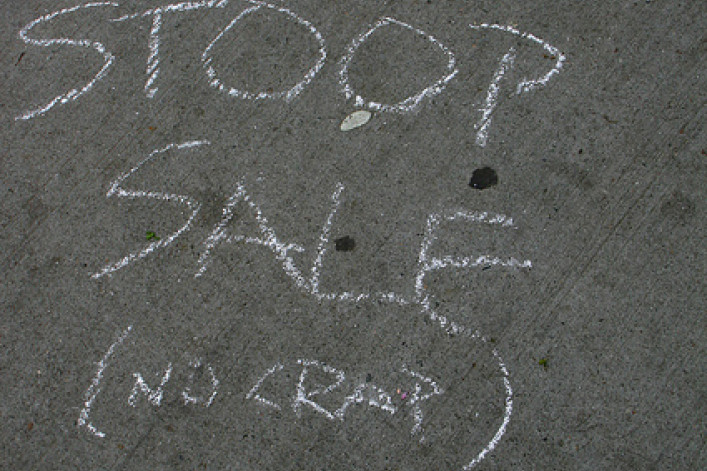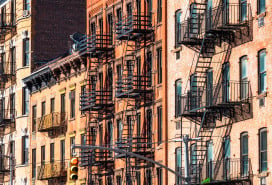Live
Pare down your stuff: How to prep for a super-successful, no-fail NYC stoop sale

Summer moving season is here, meaning across the city, plenty of us are cleaning out their jam-packed closets and paring down on worldly goods. And since few of us have garages and yards, we have to improvise, using stoops, stairs, and sidewalks as selling venues.
Stoop sales are a great for clearing out junk and make some extra cash while doing so, not to mention a fun way to socialize with neighbors (if that’s your thing). Even celebrities like Spike Lee have been known to have stoop sales of one sort or another. The De Blasios had (a free) one before they relocated to Gracie Mansion.
But what should you sell? And is it worth hauling old furniture down five flights of stairs in hopes of selling it? We break down the basics to give you the skinny on this uniquely New York experience.
FIRST THINGS FIRST
Have everything organized well before the sale, properly labeling, sorting and pricing items. But don’t waste too much time. Smaller knickknacks like old paperbacks and records should typically go for a flat rate ($1, maybe, if you take after The Strand’s model for moving books). It’s also good to have a fair amount of cash on hand in various denominations so you can easily make change.
If you don’t have a traditional stoop, not to worry! You can always rent tables or use a sheet and set up shop on the sidewalk, no permit required. Just make sure people can still pass by.
SELL THIS, NOT THAT
Nearly all traffic will be coming on foot, and many weren’t originally planning to buy something, so think about selling things that people can easily carry away with them – kitchenware, for instance, like toasters and coffee makers, plus pillows, throws, clothes, trinkets, books and records.
Big ticket items like furniture, or valuables like antiques or heirloom jewelry, aren’t good for stoop sales since they’re difficult — or simply impossible — to transport. (They're also easily stolen.) It’s best to stay away from things like speakers and televisions, since buyers can't plug those in and have only your word on whether or not it even works.
CREATE A FEAST FOR THE EYES
No one likes sifting through teetering piles of wadded-up clothes and cluttered boxes of tchotchkes to find an item. Make sure you group things together (clothes hung on a garment rack or folded neatly on a table, records and pictures in boxes). If you need inspiration, look around a shop like Anthropologie or a department store to see how items are displayed. A little mise en place can go a long way.
IF YOU’RE SHOPPING
Brooklyn neighborhoods like Park Slope, Carroll Gardens, Clinton Hill, Fort Greene, and Prospect Heights have some of the best – and most frequent – stoop sales in the city, thanks in part to a lot of stoops and the kinds of people who live above them. Park Slopers usually stoop on Sundays, and there are fliers and Craigslist ads in addition to Block Association announcements for your local neighborhoods.
Manhattan neighborhoods like the East and West Village sometimes have stoop sales or block parties with residents of the area selling goods. The Upper West Side has been known to host them, too.
ALL TOGETHER NOW
You’re more likely to encourage people to stop and enjoy a stoop sale if there are more people in on it. Block associations around the city have delegated days for street sales, and sometimes even get permission from the city to shut down the street to motor traffic, making it the perfect time to get rid of that old table lamp or record collection. Ask building management if your block has one, and suggest a street-wide sale if you haven't held one yet. There's power in numbers. Plus, it's more fun.
IF AT FIRST YOU DON’T SUCCEED…
When the day’s half done, it’s a good idea to start lowering prices, offering goods at 30 to 60 percent off – especially if the goal is to get rid of the most stuff you can.
Just because your items didn’t sell at the stoop sale doesn’t mean you have to throw them out or wait until the next one. Of course, good old Craigslist is the typical outlet for used stuff, or better yet, try NYC Stuff Exchange, which lets New Yorkers list items they want to buy, sell, or donate, with the idea of trying to reduce waste.
You can also donate gently-used clothes, furniture, and home goods to places like Housing Works or Salvation Army.
Related:
Brick Underground articles occasionally include the expertise of, or information about, advertising partners when relevant to the story. We will never promote an advertiser's product without making the relationship clear to our readers.
























